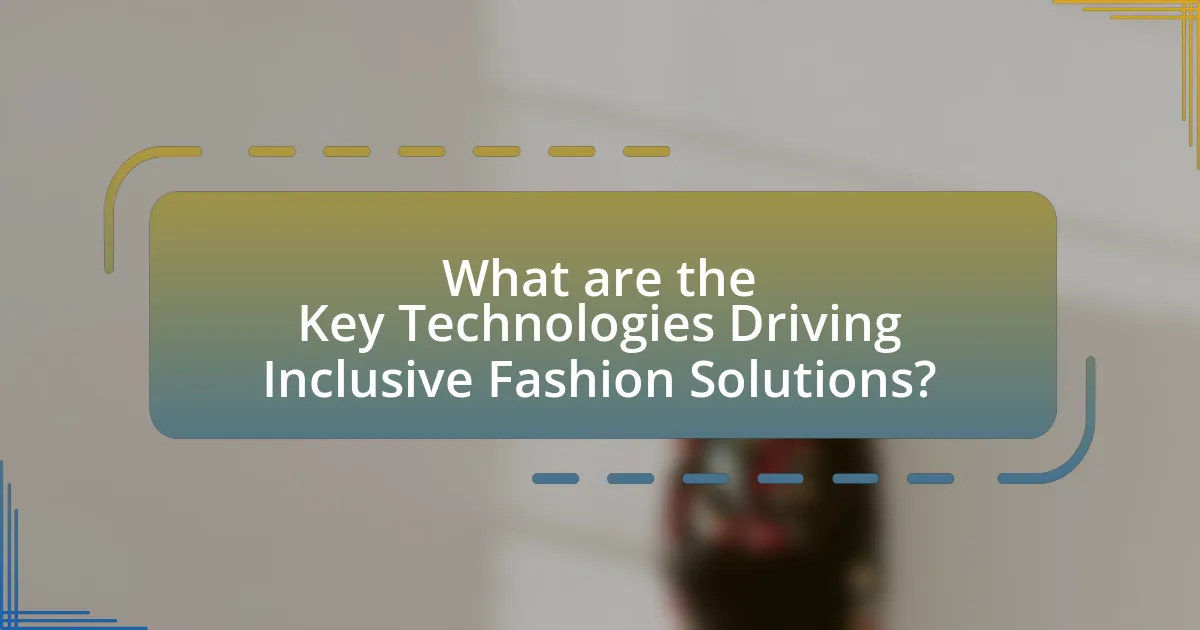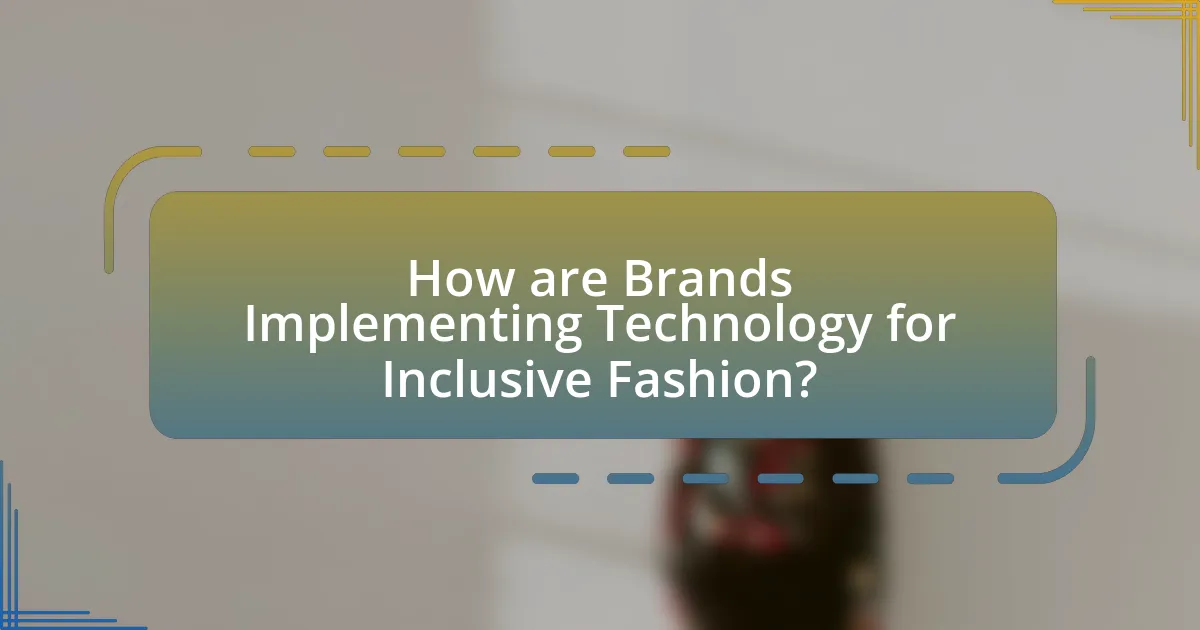The article examines how technology is transforming the fashion industry, particularly in promoting inclusivity. It highlights innovations such as 3D printing, artificial intelligence, and augmented reality, which enhance design processes, improve supply chain efficiency, and create personalized shopping experiences. Key discussions include the role of technology in addressing diverse body types, enhancing accessibility, and fostering inclusivity in fashion. The article also explores the social implications of inclusive fashion, consumer behavior trends, and successful case studies of brands implementing technology-driven solutions. Overall, it underscores the importance of inclusivity in today’s fashion landscape and the impact of technological advancements on consumer engagement and market growth.

How is Technology Transforming the Fashion Industry?
Technology is transforming the fashion industry by enabling innovative design processes, enhancing supply chain efficiency, and improving customer engagement. For instance, 3D printing allows designers to create intricate patterns and prototypes rapidly, reducing the time from concept to production. Additionally, data analytics and artificial intelligence optimize inventory management and predict fashion trends, leading to more sustainable practices. According to a report by McKinsey & Company, the integration of technology in fashion can reduce lead times by up to 75%, significantly impacting how brands operate. Furthermore, virtual fitting rooms and augmented reality applications enhance the shopping experience, allowing consumers to visualize clothing on themselves before purchase, which can increase conversion rates. These technological advancements collectively contribute to a more efficient, responsive, and inclusive fashion industry.
What role does technology play in promoting inclusivity in fashion?
Technology plays a crucial role in promoting inclusivity in fashion by enabling brands to create diverse and accessible products for all body types and abilities. Innovations such as 3D body scanning and virtual fitting rooms allow for personalized sizing, ensuring that garments fit a wider range of consumers. Additionally, advancements in adaptive clothing design, facilitated by technology, cater to individuals with disabilities, enhancing their ability to express personal style. For instance, brands like Tommy Hilfiger and Nike have utilized technology to develop adaptive lines that incorporate features like magnetic closures and adjustable fits, demonstrating a commitment to inclusivity.
How are advancements in technology addressing diverse body types?
Advancements in technology are addressing diverse body types by enabling personalized sizing and fit solutions through 3D body scanning and AI-driven algorithms. These technologies allow brands to create garments that cater to a wider range of body shapes and sizes, enhancing comfort and style for all consumers. For instance, companies like Fit3D and 3DLOOK utilize body scanning technology to capture precise measurements, which can then be used to produce custom-fit clothing. Additionally, AI algorithms analyze consumer data to predict sizing needs, leading to more accurate inventory and reduced returns. This approach not only improves the shopping experience but also promotes inclusivity in fashion by ensuring that diverse body types are represented and catered to in clothing lines.
What technologies are being utilized to enhance accessibility in fashion?
Technologies such as 3D printing, augmented reality (AR), and artificial intelligence (AI) are being utilized to enhance accessibility in fashion. 3D printing allows for customized clothing and accessories tailored to individual needs, enabling people with disabilities to find better-fitting options. Augmented reality applications help users visualize how clothing will look on them, accommodating various body types and preferences. Artificial intelligence algorithms analyze consumer data to recommend styles that suit diverse body shapes and sizes, promoting inclusivity. These technologies collectively contribute to a more accessible fashion industry by addressing the unique requirements of individuals with different abilities.
Why is inclusive fashion important in today’s society?
Inclusive fashion is important in today’s society because it promotes diversity and representation, ensuring that individuals of all body types, abilities, and backgrounds have access to clothing that fits and reflects their identity. This inclusivity not only enhances self-esteem and body positivity among consumers but also drives economic growth by expanding market reach; for instance, the global adaptive clothing market is projected to reach $400 billion by 2026, highlighting the demand for fashion that caters to a wider audience. By embracing inclusive fashion, brands can foster a sense of belonging and community, ultimately contributing to a more equitable society.
How does inclusive fashion impact consumer behavior?
Inclusive fashion significantly impacts consumer behavior by fostering a sense of belonging and representation among diverse groups. When brands offer clothing that accommodates various body types, abilities, and identities, they attract a broader customer base, leading to increased brand loyalty and sales. Research indicates that 67% of consumers are more likely to purchase from brands that demonstrate inclusivity in their marketing and product offerings. This shift in consumer behavior is driven by the desire for authenticity and relatability, as individuals seek brands that reflect their values and experiences. Consequently, inclusive fashion not only enhances customer satisfaction but also drives market growth by tapping into previously underserved demographics.
What are the social implications of inclusive fashion solutions?
Inclusive fashion solutions promote social equity by ensuring that individuals of all body types, abilities, and backgrounds have access to stylish and functional clothing. This approach fosters a sense of belonging and self-expression among marginalized groups, enhancing their visibility in society. Research indicates that inclusive fashion can positively impact mental health by reducing stigma and promoting body positivity, as seen in campaigns by brands like Aerie, which reported a 20% increase in sales after embracing diverse body representation. Furthermore, inclusive fashion encourages industry-wide changes, pushing brands to adopt more ethical practices and consider the diverse needs of consumers, ultimately leading to a more inclusive society.

What are the Key Technologies Driving Inclusive Fashion Solutions?
Key technologies driving inclusive fashion solutions include 3D printing, artificial intelligence (AI), and augmented reality (AR). 3D printing enables the customization of clothing to fit diverse body types, allowing for personalized designs that cater to individual needs. AI assists in analyzing consumer data to predict trends and preferences, ensuring that fashion brands can create inclusive collections that resonate with a broader audience. AR enhances the shopping experience by allowing customers to virtually try on clothes, making it easier for individuals with disabilities or those who face challenges in traditional fitting rooms to find suitable apparel. These technologies collectively contribute to a more inclusive fashion landscape by addressing the unique requirements of various consumer groups.
How is 3D printing revolutionizing clothing design for inclusivity?
3D printing is revolutionizing clothing design for inclusivity by enabling the creation of custom-fit garments tailored to individual body shapes and sizes. This technology allows designers to produce clothing that accommodates diverse body types, including those with disabilities or unique proportions, which traditional manufacturing methods often overlook. For instance, brands like Unspun utilize 3D printing to create jeans that fit perfectly based on a customer’s specific measurements, reducing waste and enhancing comfort. Additionally, 3D printing facilitates rapid prototyping, allowing designers to iterate quickly and incorporate feedback from a wider range of consumers, further promoting inclusivity in fashion.
What are the benefits of 3D printing for custom-fit clothing?
3D printing offers significant benefits for custom-fit clothing by enabling precise tailoring to individual body shapes and sizes. This technology allows for the creation of garments that fit perfectly, reducing the need for alterations and minimizing fabric waste. According to a study published in the Journal of Fashion Technology & Textile Engineering, 3D printing can decrease material waste by up to 90% compared to traditional garment manufacturing methods. Additionally, 3D printing facilitates rapid prototyping, allowing designers to quickly iterate on designs and produce unique pieces that cater to diverse body types, thus promoting inclusivity in fashion.
How does 3D printing reduce waste in the fashion industry?
3D printing reduces waste in the fashion industry by enabling on-demand production, which minimizes excess inventory and material usage. Traditional manufacturing often results in significant waste due to overproduction and the cutting of fabric, whereas 3D printing allows designers to create items only as needed, thus reducing the surplus of unsold goods. According to a study by the Ellen MacArthur Foundation, the fashion industry generates 92 million tons of waste annually, and adopting 3D printing can significantly lower this figure by streamlining the production process and utilizing materials more efficiently.
What role does artificial intelligence play in inclusive fashion?
Artificial intelligence plays a crucial role in inclusive fashion by enabling personalized design and improving accessibility for diverse body types and needs. AI algorithms analyze consumer data to create customized clothing options that cater to various sizes, shapes, and preferences, thereby promoting inclusivity. For instance, brands like ASOS and Nike utilize AI-driven tools to offer tailored recommendations and virtual fitting rooms, enhancing the shopping experience for all individuals. This data-driven approach not only increases customer satisfaction but also drives sales by addressing the unique requirements of a broader audience.
How can AI personalize shopping experiences for diverse consumers?
AI can personalize shopping experiences for diverse consumers by analyzing individual preferences, behaviors, and demographics to deliver tailored recommendations and content. For instance, AI algorithms can process vast amounts of data from user interactions, such as browsing history and purchase patterns, to suggest products that align with a consumer’s unique style and needs. Research from McKinsey indicates that personalized experiences can lead to a 10-30% increase in sales, demonstrating the effectiveness of AI in enhancing consumer engagement and satisfaction. By leveraging machine learning and natural language processing, AI can also adapt to cultural nuances and preferences, ensuring that diverse consumer groups feel represented and catered to in their shopping journeys.
What are the challenges of implementing AI in fashion retail?
The challenges of implementing AI in fashion retail include data privacy concerns, integration with existing systems, and the need for skilled personnel. Data privacy is critical as retailers must protect customer information while complying with regulations like GDPR. Integration poses difficulties because many retailers operate on legacy systems that may not easily accommodate new AI technologies. Additionally, the fashion industry faces a shortage of skilled professionals who can effectively develop and manage AI solutions, which hinders successful implementation. These challenges can significantly impact the efficiency and effectiveness of AI applications in the retail sector.

How are Brands Implementing Technology for Inclusive Fashion?
Brands are implementing technology for inclusive fashion by utilizing advanced tools such as 3D body scanning, AI-driven design software, and virtual fitting rooms. These technologies enable brands to create clothing that accommodates a diverse range of body types and sizes, ensuring that fashion is accessible to all consumers. For instance, companies like ASOS and Nike have adopted 3D scanning technology to gather precise body measurements, allowing for better-fitting garments. Additionally, AI algorithms analyze customer data to predict trends and preferences, which helps brands design more inclusive collections. Virtual fitting rooms, employed by brands like Zara, allow customers to try on clothes digitally, enhancing the shopping experience for individuals with disabilities or those who may find traditional fitting rooms challenging. This integration of technology not only promotes inclusivity but also drives sales by catering to a broader audience.
What strategies are brands using to integrate technology in their inclusive fashion lines?
Brands are integrating technology in their inclusive fashion lines through strategies such as utilizing 3D body scanning for personalized fit, employing augmented reality for virtual try-ons, and leveraging data analytics to understand diverse consumer needs. For instance, companies like Nike and Adidas have adopted 3D scanning technology to create custom-fit shoes, ensuring comfort for a wider range of foot shapes and sizes. Additionally, augmented reality applications allow customers to visualize how clothing will look on them without physical trials, enhancing accessibility for individuals with disabilities. Data analytics further enables brands to tailor their offerings based on insights from various demographics, ensuring that their products meet the specific requirements of diverse consumers.
How are collaborations between tech companies and fashion brands shaping the market?
Collaborations between tech companies and fashion brands are reshaping the market by integrating innovative technologies into fashion design, production, and retail processes. These partnerships enhance consumer experiences through advancements such as augmented reality for virtual try-ons, artificial intelligence for personalized shopping recommendations, and blockchain for supply chain transparency. For instance, the collaboration between Nike and Apple led to the development of the Nike+ app, which revolutionized how consumers engage with fitness and fashion. Additionally, a report by McKinsey & Company highlights that technology-driven collaborations can increase operational efficiency and reduce costs, ultimately leading to more sustainable practices in the fashion industry.
What are some successful case studies of inclusive fashion technology?
Successful case studies of inclusive fashion technology include the collaboration between Tommy Hilfiger and the non-profit organization Runway of Dreams, which launched a line of adaptive clothing for individuals with disabilities. This collection features functional designs such as magnetic closures and adjustable hems, making fashion accessible. Another example is the use of 3D printing technology by brands like Unspun, which creates custom-fit jeans tailored to individual body shapes, promoting inclusivity for diverse body types. Additionally, the app Aira connects visually impaired users with trained agents who provide real-time assistance while shopping, enhancing the shopping experience for those with visual impairments. These case studies demonstrate how technology can effectively address the needs of underrepresented groups in the fashion industry.
How can consumers support inclusive fashion initiatives?
Consumers can support inclusive fashion initiatives by actively choosing to purchase from brands that prioritize diversity and representation in their designs and marketing. By selecting products from companies that showcase models of various sizes, ethnicities, and abilities, consumers directly influence the market demand for inclusivity. Research indicates that 67% of consumers are more likely to buy from brands that demonstrate a commitment to diversity, highlighting the impact of consumer choices on brand practices. Additionally, engaging with and promoting inclusive fashion brands on social media amplifies their visibility and encourages other consumers to make similar choices, further driving the industry towards inclusivity.
What are the best practices for consumers to promote inclusivity in fashion?
Consumers can promote inclusivity in fashion by actively supporting brands that prioritize diverse representation and ethical practices. This includes choosing to purchase from companies that offer a wide range of sizes, styles, and designs that cater to various body types, ethnicities, and gender identities. Research indicates that brands with inclusive marketing strategies see a 30% increase in customer loyalty, demonstrating the financial viability of inclusivity. Additionally, consumers can advocate for change by engaging with brands on social media, providing feedback, and participating in campaigns that highlight the importance of inclusivity in fashion. By making informed purchasing decisions and voicing their support for inclusive practices, consumers can drive the industry towards greater diversity and representation.
How can consumers advocate for technology-driven inclusive solutions in fashion?
Consumers can advocate for technology-driven inclusive solutions in fashion by actively supporting brands that prioritize inclusivity through innovative technologies. By choosing to purchase from companies that utilize adaptive clothing designs, 3D printing, or AI-driven personalization, consumers signal their demand for inclusivity. Research indicates that 70% of consumers are more likely to buy from brands that demonstrate social responsibility, including inclusivity in their offerings. Additionally, consumers can leverage social media platforms to raise awareness about the importance of inclusive fashion technologies, thereby influencing brand practices and encouraging wider industry adoption.














